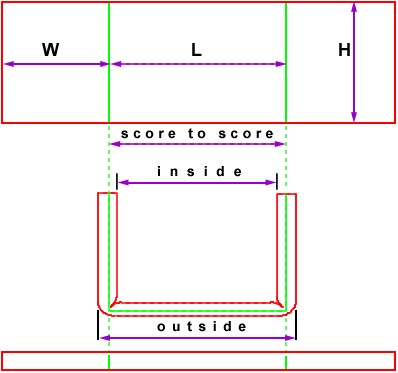The Main parameters group contains the main parameters of the box: length (L), width (W), height (H), board thickness (d), flute direction (FD), dimension type (DT) and, in most standards, a "switch" parameter defining if layers should be used (UL). Many of the other parameters depend on the values of these parameters.
The Flutes group of selection entries ( accessible as a selection type in the FEFCO parameter template ) contains the whole range of standard board widths: e.g. flF=1 (flute F), flE=1.5 (flute E), flB=2 (flute B), flC=3 (flute C), flA=4 (flute F), flEB=5 (flute EB), flEC=7 (flute EC), etc. The board thickness parameter (d) should be equal to one of these flute parameters.
Here is an example, with a cross-section, for better visualization:

Size corrections are separated into different parameters. Those corrections that only depend on the flute ( the width of the board ), on the flute direction ( parallel- or cross-to-corrugation ) and on the dimension type ( inside, outside or score-to-score ) are defined as a standalone Corrections group of parameters. The group contains both parallel-to-corrugation and cross-to-corrugation, inside and outside corrections for single crease ( 90 degrees folding - e.g. PCI90, PCO90, CCI90, CCO90 ) and for double crease ( 180 degrees folding ), with 0, 1, 2 flaps between the walls, etc. Generally, all the parameters in the Corrections group use ready predefined functions from the FEFCO parameter template; the parameters themselves are predefined in the template, too.
Multi-interval ( SWITCH ) functions are used to represent the correspondence between the flute and the values of the corrections. E.g. in the function ( predefined in the FEFCO template, using the flute value ( d ) as its argument:
PCI90(d) = switch (d;flF;0.5;flE;0.75;flB;1;flC;2;flA;3;flEB;4;flEC;5) /i.e. parallel to corrugation inside correction when the folding is at 90 degrees/
The parameters, which are to utilize such functions ( PCI90, PCO90, CCI90, CCO90 ), should not include in their expressions the functions only, because the functions alone do not take into account the flute direction and the dimension type, but only the flute ( d ) Therefore we defined additional complex functions reflected then in correction parameters - C90X ( correction when the folding is at 90o and is parallel to the Ox axis ) and C90Y ( correction when the folding is at 90° and is parallel to the Oy axis ), as well as corrections for their inside and outside dimension type counterparts - I90X, I90Y, O90X, O90Y. These parameters select the proper correction parameter ( PCI90, PCO90, CCI90, CCO90 ), according to the flute direction and dimension type given. E.g.:
C90y(d;FD;DT) = switch (DT;dtID;I90y(d;FD);dtSS;0;dtOD;-O90y(d;FD)) /this is a function/
C90Y = C90y(d;FD;DT) /this is a parameter/
Generally, you would hardly ever need to modify any of these parameters - the things you would have to change most often are the parameters in the Main group: flute type ( d ), the flute direction ( FD ), the dimension type ( DT ), as well as the length ( L ), width ( W ) and height ( H ) of the box. This is why all the Corrections group parameters are hidden.
The Main, Flute, Flute Direction, Dimension Type and Corrections parameters are common for all Corrugated base components and hence for the whole designs. This is why they are present, in various arrangements, in all FEFCO standards, by means of the FEFCO parameter template attached.
Each Corrugated standard contains a Score-to-score parameters group. The group contains the real score-to-score parameters ( Lss instead of L for length, Wss instead of W for width, Hss instead of H for height ). Actually, these parameters take into account the main parameters L, W and H as well as some corrections, thus reflecting the dimension type, the flute direction, the flute, the folding direction, the folding type ( single or double crease ), etc. However, when you want to resize the length of the design, for instance, it is recommended that you change the expression of the main parameter L rather than that of the score-to-score parameter Lss - Lss automatically takes into account the new value of L and resizes the box as appropriate.
During the process of assembling the Corrugated standards as ready resizable designs out of components, the various components have added their specific parameters as agents in different parameter groups. E.g. the glue flap component in the 0200 FEFCO group of standards has added the glue flap width GL and glue flap angle GLA parameters to a separate Glue Flap parameters group; the snap lock parameters are positioned in a Snap Lock group, etc. All of these design-specific parameter groups are described separately for each of the standards, according to the type of the standard and the parameters it uses.
Each Corrugated resizable design contains a pre-designed Corrugated Symbol component. Its purpose is to display in a proper way the flute direction that it takes into account. The parameters of the Corrugated Symbol component - EH, EW and EHX - are differentiated into a separate Corrugated Symbol group as well.